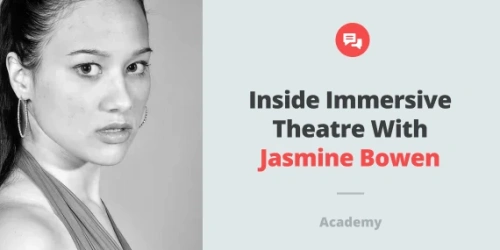- What Is Method Acting?
- What Is Stanislavski's System?
- How Did Stanislavski's Techniques Shape Modern Acting?
- Did Stanislavski Ultimately Pioneered Method Acting?
- Why Is Method Acting So Common Amongst Today's Performers?
If you follow the entertainment industry, you probably have already heard about method acting. Some performers use it with each and every role, in the process of gathering news headlines due to it. Some performers have strong opinions against it. But do you know where it all began?
Continue reading below to delve deep into the origins of modern acting and how it ultimately shaped the method acting of today's performers.
What Is Method Acting?
Method acting is a technique in which an actor aspires to complete emotional identification with a part by blurring the line between themselves and the role played. Actors practicing method acting believe that by connecting, understanding, and experiencing the inner motivations and emotions of their characters, they will ultimately elicit more authentic and expressive performances.
Method acting is based on Konstantin Stanislavski’s acting system that he developed in the early 20th century.
What Is Stanislavski's System?
Stanislavski’s system is a systematic approach to training actors that the Soviet Russian theatre practitioner Konstantin Stanislavski developed. He was recognized as an outstanding character actor, and the productions that he directed garnered him a reputation as one of the leading theatre directors of his generation, yet his legacy primarily lies in his actor training, preparation, and rehearsal technique system.
Stanislavski's system originated in 1906, due to his persistent efforts to remove the blocks that he encountered in his own acting performances. As a director, he produced his early work using an external, director-centered technique that strove for an organic unity of all its elements, known as “gesamtkunstwerk”. In each production, Stanislavski in advance planned the interpretation of every role, blocking, which is the precise staging of actors to facilitate the performance, and the “mise en scène”, which means the stage design and arrangement of actors in scenes in detail. Finally, he also introduced a period of discussion and detailed analysis of the play by the cast into the production process.
Despite Stanislavski's successful stagings of the plays of Anton Chekhov and Maxim Gorky in the style of Naturalistic, which attempted to create an illusion of reality through a range of dramatic and theatrical strategies, he remained unsatisfied and began to develop the more actor-centered techniques of "psychological realism", with his focus shifting from productions to the rehearsal process and pedagogy.
As a result, Stanislavski pioneered the use of theatre studios to innovate actor training and to experiment with new forms of theatre. He organized his techniques into a coherent, systematic methodology, which built on three major strands of influence: (1) the director-centered, unified aesthetic and disciplined, ensemble approach of the Meiningen company; (2) the actor-centered realism of the Maly; and (3) the Naturalistic staging of Antoine and the independent theatre movement. The earliest reference to his system appears in 1909, the same year that he first incorporated it into his rehearsal process. The Moscow Art Theatre adopted it as its official rehearsal method two years later.
As opposed to the more common “art of representation”, which means the acting approach where actors prepare for their roles during rehearsals and then perform those roles on stage with accuracy and artistic finish, Stanislavski's system focuses on cultivating the “art of experiencing”. By applying it, actors aim to live their characters afresh each time they perform, retaining an improvisatory quality.
He further expanded his system with the “Method of Physical Action,” which emphasized a physically grounded rehearsal process that minimized table discussions and encouraged active representation through improvisation of dramatic situations.
"The best analysis of a play is to take action in the given circumstances,” Stanislavski argued.
How Did Stanislavski's Techniques Shape Modern Acting?
From then on up until today, Stanislavski's system has been widely promoted and developed by acting teachers who were influenced by him, leading to its acceptance and influence on acting practices all over the world. His pioneered techniques have crossed cultural boundaries and are considered sort of a common sense in acting, even if actors may not be explicitly aware they are using his methods in their craft.
Stanisavski's system's legacy for the art of acting can summarized in these key aspects:
Stanislavski’s system introduced a new way of training actors, in which the focus shifted towards internal processes, emotional authenticity, and psychological realism. His newfound emphasis on understanding a character’s motives, objectives, and inner life later transformed acting education all over the world.
Rehearsal techniques, character development, and actor-director collaboration outlined within Stanislavski's system also have made a lasting impact on theater practices. Artists involved in the productions of classic plays or new works, including directors and actors, continue to draw inspiration from Stanislavski's techniques to this day.
Despite originating in Russia, Stanislavski's system affected performing arts all around the world thanks to translations of his writings. Importantly, his students later also spread his teachings globally through their performances, catching the interest of their peers aboard.
As of 2024, Stanislavski's system has long crossed cultural boundaries and influenced acting techniques in diverse theatrical tradition environments.
As mentioned above, Konstantin Stanislavski developed his system in the early 20th century. Despite being over a century old, Stanislavski’s system remains relevant in performing arts to this day. Generation after generation, actors and directors still study methods he pioneered, adapt them to contemporary contexts and find value in Stanislavski's insights about the art of acting.
Did Stanislavski Ultimately Pioneered Method Acting?
Stanislavski’s system ultimately developed and laid the foundation for what later became known as method acting.
One key aspect of Stanislavski's system is the use of emotional memory, which is now an important part of method acting. Through it performers draw on their own past experiences and emotions to enhance their performances. According to this method, a performer's entrance onto the stage is seen as a continuation of the character’s life rather than a distinct beginning. By using this approach, actors try to maintain authenticity and depth in their portrayals by connecting with their characters on a personal level, instead of simply playing another part.
The system also emphasizes training in concentration and sensory awareness to enable actors to respond authentically in the same way as method acting does. By observing people in various situations and developing a wide emotional range, actors can try to make their performance's actions and reactions appear lifelike. This focus on realism distinguishes method acting from more traditional forms of acting performances.
In the 1930s, Lee Strasberg, a director associated with the Group Theatre in New York City, adapted elements of Stanislavski’s system into what finally became known as “the Method”.
This method acting approach focuses on emotional authenticity, psychological realism, and immersive character preparation. By incorporating principles such as emotional memory, continuous characterization, sensory awareness, and empathetic observation into their training and performances, performers following the Stanislavski method indeed laid the foundation for method acting as it is known today.
Konstantin Stanislavski himself detailed the initial method acting approaches in his books “An Actor Prepares,” “Building a Character,” and “Creating a Role.”
Why Is Method Acting So Common Amongst Today's Performers?
Besides aiming to reach new levels of emotional authenticity and character depth, actors who use the method acting approach often spend considerable time researching their roles, for certain periods of time actually living the lifestyle of a character they are set to portray, or avoiding breaking character during the production process. It is so common among actors now because it is believed such an approach results in more complex and nuanced performances.
Some of the initial Hollywood stars who adopted elements of Stanislavski’s system's approach were icons like Marlon Brando, James Dean, and Marilyn Monroe. This led to a new style of performance that put emphasis on emotional truth and immersion in an acting role.
In recent decades, actors like Daniel Day-Lewis, and Leonardo DiCaprio are famously amongst performers who also tend to employ these techniques initially pioneered by Konstantin Stanislavski.
Here are some of the most acclaimed examples of method acting:
- Al Pacino
To prepare for his role in the 1992 drama Scent of a Woman, Pacino consulted the sight impaired for advice and ended up living his daily life on the film production set as if he were blind. He ended up winning the Academy Award for Best Actor for this performance.
- Robert De Niro
While preparing for his iconic role as Travis Bickle in the 1976 neo-noir psychological thriller film Taxi Driver, De Niro actually worked as a cab driver in New York City to study the behavior of drivers in this industry. More apparently for the average viewer, in the 1980 American biographical sports drama Raging Bull, he extensively both lost and gained weight for the role of the middleweight boxing champion Jake LaMotta.
- Christian Bale
English actors' drastic weight changes for roles are world-famous. From losing nearly 70 pounds for the 2004 psychological thriller The Machinist role to gaining extra 40 pounds for the role of former U.S. Vice President Dick Cheaney in the 2018 biographical film Vice, movie lovers can clearly see Bale's dedication to method acting.
- Daniel Day-Lewis
For his lead role as Nathaniel "Hawkeye" Poe in the 1992 historical epic The Last of the Mohicans, the English actor lived a whole month in the woods of North Carolina. During his time in the wilderness, Day-Lewis learned to hunt and skin animals, fight with tomahawks, and run and gun with a heavy 12-pound flintlock.
Method acting has its critics too, though. They argue that this approach can lead to over-indulgence and blurring the lines between reality and fiction too much, often resulting in bizarre behavior that seemingly brings value to the actual performance. In these cases, method actors even take it to the extremes of risking their physical and mental health for the sake of roles.
That often results in public disapproval of their cast mates and production teams, while gaining extra publicity from the media for the project. In 2023, HBO's Succession star Brian Cox went on the record to call his fellow cast mate Jeremy Strong's method of acting “annoying”. “He’s still that guy because he feels if he went somewhere else he’d lose it,” Cox said. “But he won’t! Strong is talented. He’s gifted. When you’ve got the gift, celebrate the gift.”
Amongst such controversial examples of method acting have been:
- Jared Leto
During the production of the 2016 superhero movie Suicide Squad, Leto to very divisive results portrayed the iconic DC villain Joker. His portrayal did not end offscreen, with Leto remaining in character as Clown Prince of Crime for the interactions with cast mates. This resulted in gifting Margot Robbie a live rat, while others ended up with receiving more disgusting items from him.
- Shia Labeouf
For the 2014 war drama Fury, the actor felt makeup was not enough for his portrayal as World War II tank gunner Boyd "Bible" Swan. This resulted in him making the sole decision to actually cut his own face to accurately portray battle scars and even remove a tooth.
Later, for his role as Creeper in the 2020 crime drama The Tax Collector, Labeouf infamously got his entire chest permanently tattooed. The tattoo appeared in the movie for less than three seconds.
- Austin Butler
More recently, Butler starred as Elvis Presley in the 2022 biographical drama Elvis. For three years of the movie's production, he did not break character for anyone, including his family. Butler actually has admitted it made him lose touch with who he was himself, to the point of not being able to stop speaking in Presley's southern accent.
Regardless of how someone may view method acting due to its controversies, it continues to be an influential force in today’s cinematic landscape, with aspiring actors being inspired by the levels of depth and authenticity in the performances of their idols who employed method acting. Film schools all over the world continue to teach Stanislavski’s system, emphasizing the emotional memory and character immersion he pioneered.
Method acting remains an essential part of contemporary cinema due to its ability to help actors bring characters to life with depth and nuance.





